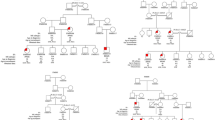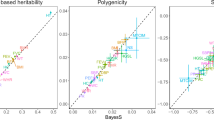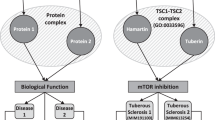Abstract
Genetic linkage and association studies define chromosomal regions, quantitative trait loci (QTLs), which influence the phenotype of polygenic diseases. Here, we describe a global approach to determine intergenomic consensus of those regions in order to fine map QTLs and select particularly promising candidate genes for disease susceptibility or other polygenic traits. Exemplarily, human multiple sclerosis (MS) susceptibility regions were compared for sequence similarity with mouse and rat QTLs in its animal model experimental allergic encephalomyelitis (EAE). The number of intergenomic MS/EAE consensus genes (295) is significantly higher than expected if the animal model was unrelated to the human disease. Hence, this approach contributes to the empirical evaluation of animal models for their applicability to the study of human diseases.
This is a preview of subscription content, access via your institution
Access options
Subscribe to this journal
Receive 6 digital issues and online access to articles
$119.00 per year
only $19.83 per issue
Buy this article
- Purchase on Springer Link
- Instant access to full article PDF
Prices may be subject to local taxes which are calculated during checkout

Similar content being viewed by others
References
Doerge RW . Mapping and analysis of quantitative trait loci in experimental populations. Nat Rev Genet 2002; 3: 43–52.
Rogner UC, Alvner P . Congenic mice. Cutting tools for complex immune disorders. Nat Rev Immunol 2003; 3: 243–252.
Lemon WJ, Swinton CH, Wang M, Berbari N, Wang Y, You M . Single nucleotide polymorphism (SNP) analysis of mouse pulmonary adenoma susceptibility loci 1–4 for identification of candidate genes. J Med Genet 2003; 40: e36.
Ibrahim SM, Mix E, Bottcher T et al. Gene expression profiling of the nervous system in murine experimental autoimmune encephalomyelitis. Brain 2001; 124: 1897–1899.
Kirkness EF, Bafna V, Halpern AL et al. The dog genome. Survey sequencing and comparative analysis. Science 2003; 301: 1898–1903.
Lu M, Kato M, Kakihara F . Destiny of a transgene escape from Brassica napus into Brassica rapa. Theor Appl Genet 2002; 105: 78–84.
Chien S, Reiter LT, Bier E, Gribskov M . Homophila: human disease gene cognates in Drosophila. Nucl Acids Res 2002; 30: 149–151.
Ureta-Vidal A, Ettwiller L, Birney E . Comparative genomics: genome-wide analysis in metazoan eukaryotes. Nat Rev Genet 2003; 4: 252–262.
Barton A, Eyre S, Myerscough A et al. High resolution linkage and association mapping identifies a novel rheumatoid arthritis susceptibility locus homologous to one linked to two rat models of inflammatory arthritis. Hum Mol Genet 2001; 10: 1901–1906.
Xu C, Dai Y, Lorentzen JC, Dahlman I, Olsson T, Hillert J . Linkage analysis in multiple sclerosis of chromosomal regions syntenic to experimental autoimmune disease loci. Eur J Hum Genet 2001; 9: 458–463.
Dyment DA, Ebers GC, Sadovnick AD . Genetics of multiple sclerosis. Lancet Neurol 2004; 3: 104–110.
Moins-Teisserenc H, Semana G, Alizadeh M et al. TAP2 gene polymorphism contributes to genetic susceptibility to multiple sclerosis. Hum Immunol 1995; 42: 195–202.
John GR, Shankar SL, Shafit-Zagardo B et al. Multiple sclerosis. Re-expression of a developmental pathway that restricts oligodendrocyte maturation. Nat Med 2002; 8: 1115–1121.
Schwab C, McGeer PL . Complement activated C4d immunoreactive oligodendrocytes delineate small cortical plaques in multiple sclerosis. Exp Neurol 2002; 174: 81–88.
Bonten EJ, Arts WF, Beck M et al. Novel mutations in lysosomal neuraminidase identify functional domains and determine clinical severity in sialidosis. Hum Molec Genet 2000; 9: 2715–2725.
Matejuk A, Dwyer J, Zamora A, Vandenbark AA, Offner H . Evaluation of the effects of 17{beta}-estradiol (17{beta}-E2) on gene expression in experimental autoimmune encephalomyelitis using DNA microarray. Endocrinology 2002; 143: 313–319.
D'Ambrosio D, Cippitelli M, Cocciolo MG et al. Inhibition of IL-12 production by 1,25-dihydroxyvitamin D3. Involvement of NF-kappaB downregulation in transcriptional repression of the p40 gene. J Clin Invest 1998; 101: 252–262.
Bennetts BH, Teutsch SM, Buhler MM, Heard RN, Stewart GJ . HLA-DMB gene and HLA-DRA promoter region polymorphisms in Australian multiple sclerosis patients. Hum Immunol 1999; 60: 886–893.
Marrosu MG, Muntoni F, Murru MR et al. Role of predisposing and protective HLA-DQA and HLA-DQB alleles in Sardinian multiple sclerosis. Arch Neurol 1993; 50: 256–260.
Mokhtarian F, Zhang Z, Shi Y, Gonzales E, Sobel RA . Molecular mimicry between a viral peptide and a myelin oligodendrocyte glycoprotein peptide induces autoimmune demyelinating disease in mice. J Neuroimmunol 1999; 95: 43–54.
McFarland HI, Lobito AA, Johnson MM et al. Determinant spreading associated with demyelination in a nonhuman primate model of multiple sclerosis. J Immunol 1999; 162: 2384–2390.
Johns TG, Bernard CC . Binding of complement component Clq to myelin oligodendrocyte glycoprotein. a novel mechanism for regulating CNS inflammation. Mol Immunol 1997; 34: 33–38.
Wang KC, Koprivica V, Kim JA et al. Oligodendrocyte-myelin glycoprotein is a Nogo receptor ligand that inhibits neurite outgrowth. Nature 2002; 417: 941–944.
Perini P, Gallo P . The range of multiple sclerosis associated with neurofibromatosis type 1. J Neurol Neurosurg Psychiatry 2001; 71: 679–681.
Barton A, Woolmore JA, Ward D et al. Association of protein kinase C alpha (PRKCA) gene with multiple sclerosis in a UK population. Brain 2004; 127: 1717–1722.
Mao Z, Bonni A, Xia F, Nadal-Vicens M, Greenberg ME . Neuronal activity-dependent cell survival mediated by transcription factor MEF2. Science 1999; 286: 785–790.
Pietrobon D . Calcium channels and channelopathies of the central nervous system. Mol Neurobiol 2002; 25: 31–50.
Zhai Q, Wang J, Kim A et al. Involvement of the ubiquitin–proteasome system in the early stages of wallerian degeneration. Neuron 2003; 39: 217–225.
Washington R, Burton J, Todd RF, Newman W, Dragovic L, Dore-Duffy P . Expression of immunologically relevant endothelial cell activation antigens on isolated central nervous system microvessels from patients with multiple sclerosis. Ann Neurol 1994; 35: 89–97.
Constantinescu CS, Goodman DB, Grossman RI, Mannon LJ, Cohen JA . Serum angiotensin-converting enzyme in multiple sclerosis. Arch Neurol 1997; 54: 1012–1015.
Constantinescu CS, Goodman DB, Hilliard B, Wysocka M, Cohen JA . Murine macrophages stimulated with central and peripheral nervous system myelin or purified myelin proteins release inflammatory products. Neurosci Lett 2000; 287: 171–174.
Styren SD, Bowser R, Dekosky ST . Expression of fetal ALZ-50 reactive clone 1 (FAC1) in dentate gyrus following entorhinal cortex lesion. J Comp Neurol 1997; 386: 555–561.
Ju Y-T, Chang ACY, She BR et al. Gas7: a gene expressed preferentially in growth-arrested fibroblasts and terminally differentiated Purkinje neurons affects neurite formation. Proc Nat Acad Sci USA 1998; 95: 11423–11428.
Stathakis DG, Hoover KB, You Z, Bryant PJ . Human postsynaptic density-95 (PSD95): location of the gene (DLG4) and possible function in nonneural as well as in neural tissues. Genomics 1997; 44: 71–82.
Regnier CH, Masson R, Kedinger V et al. Impaired neural tube closure, axial skeleton malformations, and tracheal ring disruption in TRAF4-deficient mice. Proc Nat Acad Sci USA 2002; 99: 5585–5590.
Liston P, Fong WG, Kelly NL et al. Identification of XAF1 as an antagonist of XIAP anti-caspase activity. Nat Cell Biol 2001; 3: 128–133.
Guillermet J, Saint-Laurent N, Rochaix P et al. Somatostatin receptor subtype 2 sensitizes human pancreatic cancer cells to death ligand-induced apoptosis. Proc Nat Acad Sci USA 2003; 100: 155–160.
Nivet-Antoine V, Coulhon MP, Le Denmat C et al. Apolipoprotein E and bleomycin hydrolase. Polymorphisms: association with neurodegenerative diseases. Ann Biol Clin 2003; 61: 61–67.
Valnot I, Osmond S, Gigarel N et al. Mutations of the SCO1 gene in mitochondrial cytochrome c oxidase deficiency with neonatal-onset hepatic failure and encephalopathy. Am J Hum Genet 2000; 67: 1104–1109.
Dimitrova A, Georgieva L, Nikolov I et al. Major psychiatric disorders and the serotonin transporter gene (SLC6A4): family-based association studies. Psychiatr Genet 2002; 12: 137–141.
Filion LG, Matusevicius D, Graziani-Bowering GM, Kumar A, Freedman MS . Monocyte-derived IL12, CD86 (B7-2) and CD40L expression in relapsing and progressive multiple sclerosis. Clin Immunol 2003; 106: 127–138.
Verbeek S, Izon D, Hofhuis F et al. An HMG-box-containing T-cell factor required for thymocyte differentiation. Nature 1995; 374: 70–74.
Woods ML, Kivens WJ, Adelsman MA, Qiu Y, August A, Shimizu Y . A novel function for the Tec family tyrosine kinase Itk in activation of beta-1 integrins by the T-cell receptor. EMBO J 2001; 20: 1232–1244.
Menasche G, Pastural E, Feldmann J et al. Mutations in RAB27A cause Griscelli syndrome associated with haemophagocytic syndrome. Nat Genet 2000; 25: 173–176.
Voigt C, Möller S, Ibrahim SM, Serrano-Fernández P . Non-linear conversion between genetic and physical chromosomal distances. Bioinformatics 2004; 20: 1966–1967.
Clamp M, Andrews D, Barker D et al. Ensembl 2002: accommodating comparative genomics. Nucleic Acids Res 2003; 31: 38–42.
Mooney CZ . Monte Carlo Simulation. Sage University Papers Series, Quantitative Applications in the Social Sciences No 116, Sage Publications: Thousand Oaks, London, 1997.
Acknowledgements
We thank Michael O Glocker, Michael Kreutzer, Gertrud Fischer, Brigitte Müller-Hilke and Claudia Voigt for their support. The developers of EnsEMBL are thanked for their extraordinary efforts. This work was supported by the BMBF projects FKZ 01GG9831, 01GG9841 and NBL3 (FKZ 01ZZ0108).
Author information
Authors and Affiliations
Corresponding author
Additional information
Supplementary Information accompanies the paper on Genes and Immunity website (http://www.nature.com/gene).
Supplementary information
Rights and permissions
About this article
Cite this article
Serrano-Fernández, P., Ibrahim, S., Zettl, U. et al. Intergenomic consensus in multifactorial inheritance loci: the case of multiple sclerosis. Genes Immun 5, 615–620 (2004). https://doi.org/10.1038/sj.gene.6364134
Received:
Revised:
Accepted:
Published:
Issue Date:
DOI: https://doi.org/10.1038/sj.gene.6364134
Keywords
This article is cited by
-
FocusHeuristics – expression-data-driven network optimization and disease gene prediction
Scientific Reports (2017)
-
Early B-cell Factor gene association with multiple sclerosis in the Spanish population
BMC Neurology (2005)
-
Gene expression profiling of arthritis using a QTL chip reveals a complex gene regulation of the Cia5 region in mice
Genes & Immunity (2005)



